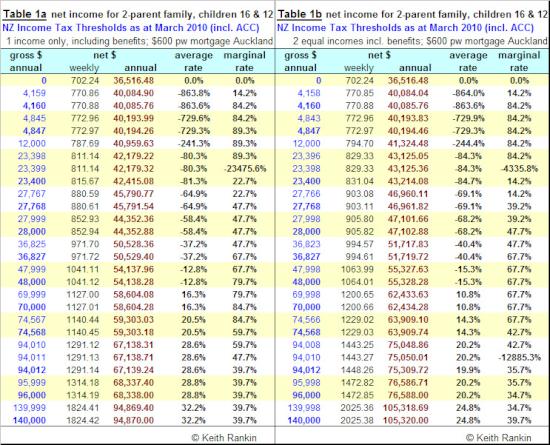Taxes and Benefits for Families: Current State plus Reform
by Keith RankinOn March 8 Scoop published my article Taxes and Benefits for Individuals: Current State and Reform Options, which looks at taxes and benefits for individual New Zealand wage and salary earners, as their earnings vary. In this article, I apply the same principles to a two-adult – Kate and Ken – two-child Auckland family with a $600 per week mortgage.
Firstly I consider a traditional one-income family, with Ken in the labour force and Kate outside the labour force. If Ken is unemployed or their earnings are low for other reasons, the principal forms of explicit benefit support are Unemployment Benefit, Accommodation Supplement, and "Family Tax Credits" (FTC). These benefits are all means-tested against household rather than individual earnings. They are conditional benefits, and not true tax credits. True tax credits are assessed individually – as are tax payments – and depend only on earnings, if that.
Secondly I consider Kate and Ken as equal breadwinners of a two income family.
For my example, Kate and Ken have children aged 12 and 16. I have chosen these ages only as a way of noting that family tax credits are slightly higher for teenage children.
Table 1a below considers Ken's income – as the sole breadwinner – in the range from $0 to $140,000. The adjacent table – Table 1b – considers the tax and benefit implications, as per current public accounting conventions, if Kate and Ken have equal gross incomes. Thus household earnings of $140,000 would be divided $70,000 to Kate and $70,000 to Ken.
If Kate and Ken both become unemployed, they qualify for benefits totalling $36,516. They will continue to be entitled to some unemployment benefit if Ken is working part-time with a modest wage rate. If Ken earns $15 per hour, he will become eligible for "in-work tax credits" (a form of family tax credit) when his annual earnings reach $23,400 (30 hours per week @ $15 per hour), and they will cease to be "unemployment beneficiaries".
While on an unemployment benefit, Ken will forego 84.2% of his extra earnings, or 89.3% if his total gross income, including grossed-up benefit, exceeds $14,000. The family's net annual income jumps by over $230 once they become eligible for "in-work tax credits".
Once Ken becomes a fulltime worker, we'll assume that his income rises mainly due to higher wage rates rather than due to more hours. At $27,768 per annum, Kate and Ken's accommodation supplement (AS), on the Auckland maximum, begins to abate at 25 cents in the dollar, raising Ken's effective marginal tax rate (EMTR) to 47.7%. At $36,827, their family tax credits start to abate, at 20 cents per dollar. This raises their EMTR to 67.7%.
At $48,000, Ken moves into the 34.7% tax bracket, raising the EMTR further, to 79.7 cents per dollar (79.7%). At $70,000, he moves to the 39.7% tax bracket. His EMTR rises for one last time, to 84.7%, meaning he keeps just 15.3% of additional earnings.
At $74,568 Kate and Ken lose the final vestiges of their accommodation supplement, so Ken's EMTR falls back to 59.7%. They now get to keep over 40% of Ken's additional earnings. Finally at an earnings level of $94,012, their entitlement to family tax credits ends, leaving Kevin on the top marginal tax rate of 39.7%. He will now have no more disposable income than he would if he had no dependents.
If Kate and Ken are both employed and earn the same wages – eg they job-share – then at higher income levels they will be much better off. While benefits cut in (eg "in work tax credits") and cut out at the same levels of household income, marginal tax rates are generally lower. By time they reach a household income of $140,000, they are over $10,000 better off if their income is split than if just Ken earns the income. This is the argument for "income-splitting for tax purposes"; it provides significant extra tax benefits for high earning households where one adult earns much more than the other.
Table 1b shows that, if Kate and Ken each earn $47,006 ($94,012 combined), then as they come off family tax credits, they each come to qualify for the present Independent Earner Tax Credit (IETC; introduced in April 2009), causing their effective average tax rates to fall.
Table 2 shows the present situation of Ken and Kate if we adopt the more principled accounting approach adopted in, for example, the March 8 article. Table 2 also shows the differences of net incomes between one-earner and two-earner households with the same combined income.

Here, all earnings are flat-taxed at 34.7% – the "trust rate" of 33% plus the ACC levy of 1.7% – with tax concessions ("non-refundable tax credits") showing as a form of benefit. Under this approach, it is apparent that all adults in a 2-parent family currently receive combined benefits of at least $13,900 if they have equal individual incomes at or below a gross household income of $140,000.
This accounting approach suggests an obvious reform; that every taxpayer should be entitled to a benefit – paid as a tax credit – of at least $6,950. Such a benefit would be a "refundable tax credit" (RTC) because, for persons with low earnings (for whatever reason), the tax credit might exceed private earnings. For beneficiaries, this RTC would represent an unconditional first tier of their overall benefit.
My preferred reform option, as indicated in earlier articles, is to slightly raise the flat tax rate (to 36.2%, including the ACC levy) and pay a refundable tax credit of $8,000 to all individuals. This reform option is presented in Table 3. For Kate and Ken and family, this first tier benefit would leave a shortfall of about $20,000 compared to their present benefit entitlements.

This shortfall would need to be made up, to some degree, by a case-managed second-tier benefit. If Kate and Ken are to experience the same EMTR (57%) suggested in the March 8 article, and that benefit was to completely disappear at the same household income that Kate and Ken's family tax credits are fully abated (ie $94.012 in this example) at present, then the benefit case-managed by Work and Income (WINZ) would start at $19,554 ($376 per week).
For a 2-income household, compared to the present, the reform leaves Kate and Ken with reduced disposable income at gross earnings below $12,000. The trade-off, firstly, is that nearly half their total benefits (the RTCs of $8,000 each for Kate and Ken) are unconditional and unabated (Table 3), whereas at present almost all of their benefits are managed through Work and Income. Secondly, under the proposed reform Kate and Ken retain 43% of additional earnings, whereas at present there are large income ranges for which they retain less than 33% of extra earnings (and just 11% earnings retention if they have only one part-time private income and earnings fall in the $5,000 to $23,000 range).
The reform provides modest gains for families on low combined incomes, with the greatest gains coming at annual household earnings in the low $20,000s and at around $70,000 combined earnings.
We can think of Kate and Ken as having had, in the good times of the mid-2000s' decade, a sufficiently high income to buy a house and be able to gain a $600pw mortgage. (Many mortgages are/were much higher.) In the more uncertain times from 2008, due to unemployment or underemployment of Kate or Ken (or both), and possibly having to take on new employment at lower wage rates, the tables here show the range of low-household-income situations they might find themselves in.
By reforming the way we account for taxes and benefits – in accordance with the principles of horizontal and vertical equity as discussed in the March 8 article – we get a clearer picture of the level of benefits paid throughout the income ranges typical for New Zealand individuals and households.
Accounting reform opens the door to policy reform. With distributive individual refundable tax credits (benefits analogous to company dividends) taking care of the horizontal equity requirement, and redistributive household-assessed case-managed and means-tested benefits taking care of the vertical equity requirement, we can achieve a personal tax-benefit regime that is fair, efficient, transparent, and competitive. The cost is a high (but realistic) percentage flat tax rate in the mid- to upper- 30s (36.2% in my proposal) that is offset by a minimum benefit ($8,000 per year in my proposal) received by all, regardless of their level of private earnings.
krankin @ unitec.ac.nz; keith @ pol-econ.com




 Binoy Kampmark: Fallibility, Dirty Wars And Pope Francis I
Binoy Kampmark: Fallibility, Dirty Wars And Pope Francis I Peter Dunne: Dunne's Weekly - An Issue No-one Can Afford To Lose
Peter Dunne: Dunne's Weekly - An Issue No-one Can Afford To Lose Martin LeFevre - Meditations: Choosing Mass Murder?
Martin LeFevre - Meditations: Choosing Mass Murder? Eugene Doyle: Quiet Mutiny - The U.S. Army Falls Apart
Eugene Doyle: Quiet Mutiny - The U.S. Army Falls Apart Gordon Campbell: Papal Picks, And India As A Defence Ally
Gordon Campbell: Papal Picks, And India As A Defence Ally Binoy Kampmark: The Selling Of America - Ending The US Dollar’s Exorbitant Privilege
Binoy Kampmark: The Selling Of America - Ending The US Dollar’s Exorbitant Privilege